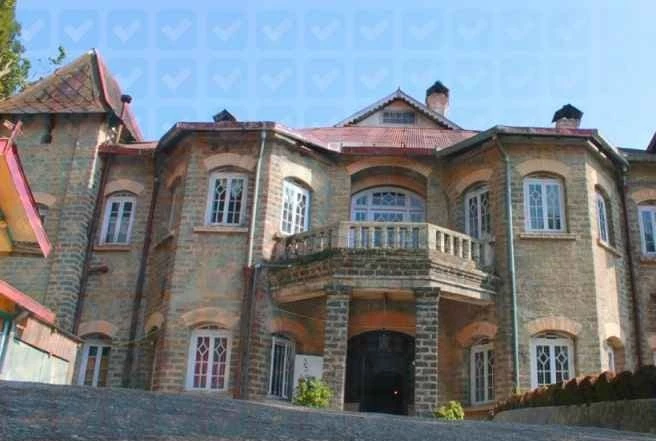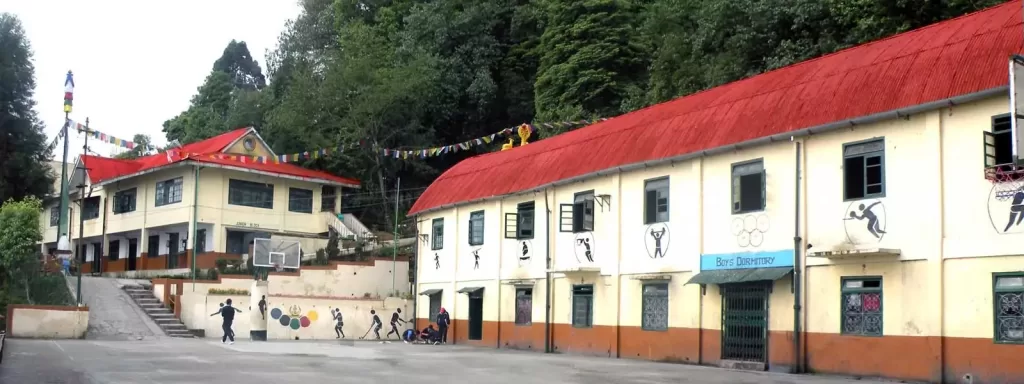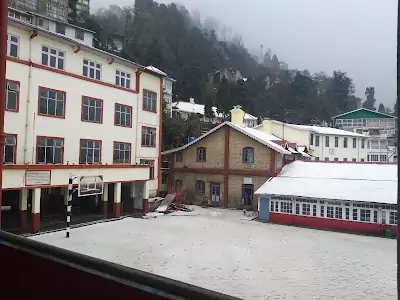The Darjeeling hills have a long and illustrious history of education and educational institutions. We looked at the function and evolution of education and educational institutions in the Darjeeling hills in Part I, focusing on missionary and government institutions for European and native learning. I am here to present the History of Education and Educational Institutions in the Darjeeling hills-Part II, which deals with collegiate and other informal education.
Table of Contents
Collegiate History of the Darjeeling hills:
Darjeeling’s collegiate history is just as rich as its school history, dating back to 1892. Several colleges are still pertinent to the colonial era in the Darjeeling hills. Let’s look at the history of the Darjeeling hills’ well-known colleges.
St. Joseph’s College, Darjeeling:

The College Section began in 1888 as a part of St Joseph’s School. In 1892, St. Joseph Seminary created the I. A. Course. Calcutta University joined the College Section (which offered the Intermediate Course) in 1927. They admitted women to the College for the first time in 1948. The College ultimately approved to offer of B.A. and B.Sc. programmes by 1949. Later, when the University of North Bengal was founded in 1962, the College was affiliated. In 1963, the College moved from the school to its current location.
Salesian College, Sonada:

The Salesians of Don Bosco, Kolkata Province, run Salesian College, a government-recognized minority Catholic educational institution. The college moved to Sonada in 1938 after being founded in Shillong in 1933. Calcutta University’s affiliation shifted to North Bengal University in 1962. With the Ministry of Rural Development and Don Bosco Tech, New Delhi, the Salesian College Extension Activities Centre has trained and placed over 600 youth in the region. Salesian Publications, Salesian Research Center, and Salesian Translation Centre provide capacity enhancement opportunities for aspiring teaching and research people in the region.
Southfield (Loreto) College, Darjeeling:

Loreto College was established as a women’s college in August 1961 at Southfield, Darjeeling. It was sponsored by the West Bengal government and was managed by Loreto nuns. The Irish Branch of the Institute of the Blessed Virgin Mary, the Darjeeling Loreto Educational Society, agreed to manage it at the request of the Government of West Bengal. Because of a lack of personnel, the Loreto Nuns handed the College to the Government of West Bengal. The college was initially affiliated with the University of Calcutta but later transferred to North Bengal University in 1962. The College was renamed Southfield College in 2008.
Similarly, Darjeeling Government College opened in 1948; Sree R.K.B.T. College and Kalimpong College in 1962; Kurseong College in 1967; Sonada Degree College in 1985; Bijanbari Degree College and Cluny College for Women in Kalimpong in 1995; Mirik College in 2000 and Ghoom Jorebunglow College established in 2004 in Jorebunglow, Darjeeling. Eleven of the 18 colleges in Darjeeling’s district are in the hilly region. All colleges offer undergraduate degree programmes accredited by the University of North Bengal.
Native Voluntary and Educational Institutions in promoting education in the Darjeeling hills:
Tols and Madrasahs were not introduced in Darjeeling until much later, in 1917 and 1910, but early settlers such as Lepchas, Bhutias, Limbus, and later Tibetans followed their non-formal educational system.
Role of the Monasteries in promoting education in the Darjeeling hills:

Monasteries provided parochial education throughout the 18th and 19th centuries. Monasteries are centers of Buddhist culture even though the standard of education is imparted to them. The Ghum Monastic School was founded in 1882 to foster friendly relations with Tibetans and other transfrontier peoples, to assist monks in their contributions to Buddhist literature, and to entice lamas to settle and educate their children.
The Tibetans place a premium on preserving and promoting their rich cultural heritage. When H.H. Dalai Lama and the government in exile arrived in India in 1959, the primary concern was the education of Tibetan children. Under the stewardship of Pandit Nehru, a unique education scheme was set up for Tibetan children. To achieve these goals, the Tibetan Schools Society was founded in 1961. Darjeeling’s Central School for Tibetans (CST) was founded in 1961, Kalimpong’s in 1964, and Sonada’s in 1975.
Pathsalas and Tols in the Darjeeling hills:
The first pathshala, Sri Pasupati Sanskrit Vidyalaya in Echhay, Kalimpong established in 1917. The Himachal Hindi Bhawan, with the assistance of the Darjeeling Municipality, introduced Sanskrit Tol in Darjeeling. Sarvodaya Gurukul Ashram in Kurseong and Sri Hareswar Sanskrit Pathshala in Lingsay was founded in 1946, respectively. At the same time, Soladevi Sanskrit tol Kalimpong was founded in 1954. Sanskrit is used as the medium of instruction here.
Madrasas and Maktabs in the Darjeeling hills:
In 1860, near the Darjeeling Mosque, the Anjuman-e Islamia was founded to improve Muslims’ social and moral conditions through Islamic teachings. In 1910 and 1920, the West Bengal Madrasha Board recognised the establishment of a Boys’ Junior Madrasha. Later, a girls’ Maktab was built near Choti Masjid. The Anjuman Islamia Maktab in Kalimpong and the Azad Primary School in Kurseong were established to impart education. Hindi is the medium of instruction in all Maktabs. Urdu is the primary language. English and Arabic are also taught because the latter is required for learning the Koran.
Voluntary Organisations in promoting native Language and Literature in the Darjeeling hills:
The Nepali Sahitya Sammelan, founded in 1924 done much to spread the influence of Nepali literature and culture and has published books. The organiser published Nepali textbooks for primary, middle, and high school. The hill people manage the Manobinod Library, founded in 1924 for their benefit. The Nepali Sahitya Parishad Darjeeling was founded with similar goals and functions.
In 1931, the Himachal Hindi Bhawan, which included a library and reading room, popularised the Hindi language and literature. In 1934, it also established a Sanskrit tol. It operates a public library with 2,250 volumes and an open reading room to the public and organises literary discourses in Hindi. The Nripendra Narayan Hall is a hub of Hindu cultural activity, primarily in Bengali, and houses a public library.
Swami Abhedananda, a renowned disciple of Shri Ramakrishna Paramahansa, founded Sri Ramakrishna Vedanta Ashrama in 1924. In 1925, the Ashrama established a free primary school for boys and an orphanage, training classes in carpentry, basket weaving, and tailoring. The Ashrama established the Sardeswari Girls’ School (Nepali Medium) and the Ramakrishna Bengali free primary school for boys in 1931.
The Young Men’s Buddhist Association established four primary schools to spread Buddhist culture among Buddhists and Hindus. The Darjeeling Branch of the All India Arya Samaj was founded in 1933 at Chowk-Bazar in Darjeeling. There are 15 public libraries in the District, most of which are in the chief towns.
Night Schools and Tea Garden Schools in Spreading Education in the Darjeeling hills :

Rev. Macfarlane raised awareness of the importance of education among tea planters. Night schools have always been essential to the Mission’s educational work. They are prevalent in tea gardens. In 1872, three schools were established for the children of tea plantation coolies at Soom, Tukvar, and Lebong. Dash writes in his gazetteer that there were 57 tea garden schools, including 17-night schools, on the eve of independence. Almost all the schools in the hills had both day and night sections attended by different students. In the tea plantations, students typically attended night school from 6 to 8:30 p.m. Some of these night schools were in Doteriah, Nagri, Mirik, Moondakothi, Soom, and Kainjilia, among other places.
Similarly, many tea garden schools educated the children of tea garden workers. In 1935, Takdah T.E. Primary School and Steinthal or Saipatri Primary School were founded. Pandham Primary School and Rangeet T.E. Saraswati Primary School were established in Chota-Patabung in 1947. The Lopchu T.E. Primary School was founded in 1960. To implement the scheme of free and compulsory primary education in rural hill areas, Darjeeling District School Board was established in 1954.
Read the review of ‘Darjeeling: In Search of People’s History of the Hills’ for more information.
History of Female Education in the Darjeeling hills:

Christian missionaries were the forerunners in female education in the hills. As elsewhere, women’s rights were violated in India in the nineteenth century. Darjeeling residents had yet to realize the benefits of female education and overcome their prejudices against it.
In 1890, the government established the Girl’s Boarding School for Nepali, Bhutia, and Lepcha girls in Darjeeling. However, because of the increased interest of Nepali girls, the school was elevated to the high school level and renamed the Nepali Girls’ High School in 1942.
Kurseong’s St. Helen’s School was established in 1890. The school was founded under the patronage of St. Helen, a British Princess, and mother of the Great Constantine, by sisters Mother Marie Therese and Sister M. Winifred.
Mrs. Graham established a separate girls’ and night school for women in Kalimpong in 1891. From 30 students in 1891 to 100 in 1914, the school grew 30 to 100. Mrs. Graham established a knitting and crocheting industrial school for girls in 1894.
The Church of Scotland mission girls’ school opened in Kalimpong in March 1905 to provide women and girls with vocational training and elementary education. In 1924, they converted it into the Kalimpong Girls’ High School. It was possibly one of the first institutions in the district to use Nepali as a medium of instruction up to the Middle examination.
Darjeeling’s Maharani Girls’ School was founded in 1908. It is the district’s first Indian-managed and privately run a school for Indian girls. Through the medium of Bengali, it provided a modern education. Hemlata Sarkar founded the school.
In Kalimpong, the Sisters of Saint Joseph de Cluny established St. Philomena Middle English Girls’ Day School for hill children in 1932. St. Joseph Girls’ School opened in Kurseong in 1938 and was upgraded to a high school in 1944.
The Women’s Association of the Church of Scotland for Foreign Mission organized several educational activities to encourage girls to attend school. They included day and boarding schools, a Nepali school in Darjeeling Bazar, a Bengali school, and a teacher training class for girls.
Private enterprises gradually emerged, with Pranami Vidya Mandir Girls’ School in Kalimpong in 1944, Saraswati School in Mungpoo in 1946, Pokhriabong School in 1947, and Griffith Memorial School in Takdah in the same year.
In Darjeeling, however, it was discovered that no less than 12% of the males, or roughly 1 in 8, were literate. During the decade ending in 1901, the proportion of literate females increased from 5 to 14 per 1,000 (approximately 1 in 71), a ratio surpassed by no other district in Bengal or Eastern Bengal outside Calcutta. The progress of education among the female population is more encouraging. Because of Miss Macfarlane’s energy and perseverance, there was only one girls’ school in the district 30 years ago. [Statistical Account of Bengal, vol. X, 1876]
Vocational/Training Institutions in the Darjeeling hills:

St. Andrew’s Colonial Homes, also known as Graham’s Homes in Kalimpong, was a vital institution for European education. The Rev. Dr. J. A. Graham is a Church of Scotland’s Guild Missionary member. Rev. Graham founded it in 1900, and saw the need to provide care and education for destitute children of the domiciled European community and industrial training. He was the Honorary Superintendent of St. Andrew’s Colonial Homes, which he founded until his death on May 15, 1942.
Mrs. Catherine Graham established a teaching-cum-training institute for hill women in 1897. This school eventually became known as Central Lace School. They renamed the school Kalimpong Industrial School for Girls after a few years. Carpentry, tailoring, and gardening are among the three vocational programmes the Kalimpong Mission Industrial School offers.
Similarly, the Goethals Memorial orphanage and school in Kurseong opened technical classes in Civil and Mechanical Engineering in 1912-13. The Shri Ramakrishna Vedanta Ashram in Darjeeling began vocational classes in carpentry, basket making, and tailoring in 1926.
Mr. Sutherland, Principal of S.U.M. Kalimpong, was the first to include sericulture as a subject in the school curriculum. In 1917, the government took a positive step by establishing the first silkworm nursery in Kurseong. Later, training centers were established in Tripai, Kalimpong, Relling, and Bijanbari.
Kurseong, in the beautiful hills of Darjeeling district, is home to the Central Academy of Forest Education college. This is the only Rangers’ College in the country. It is directly controlled by the Government of India, established in 1927. This college is solely dedicated to training Forest Range Officers from various states and union territories. The College Building is said to have been built in the late 1800s. It, along with its landed property (31.57 acres), once owned by St Mary’s Seminary of the Catholic Mission of West Bengal (Society of Jesus), was purchased by the Government of India in 1974.
The West Bengal Government, with the help of the Central Government, established an Industrial Training Centre at Tung in 1949. (Kurseong).
The District had only 322 primary schools, 23 middle English schools, 10 European or Anglo-Indian high schools, 11 Indian high schools, three intermediate colleges, 1-degree college, three craft schools, and three teachers’ training schools on the eve of independence in 1946-47. The exact figure, however, differs from the Report of Census, 1951, published in West Bengal district handbooks: Darjeeling, Calcutta, 1954. Unfortunately, unemployment in the district has become a matter of concern for many years, and Diaspora is prevalent among the youths of Darjeeling. Yet, the glorious history of education and educational institutions in the Darjeeling hills is encouraging for the people, and the educational legacy is still relevant.
Read the PART-I of the History of Education in the Darjeeling hills


Good work …👍🏻👍🏻
Very informative. Looking for more relevent articles.
Gratifying work bhai keep going.
👍👌
Your work is meritorious 👍
Awesome writeup👍🏻
Hi! kishan thanks again for a wonderful writeup. I was eagerly waiting for part II. It was yet another infromative article. Keep the good work of enlightening us with your articles.
Great work sir. Very informative. Looking forward to many such articles from you.
Superbly captured and written by you Kishan.. Splendid work..
Keep it up brother. Detailed enumeration of education and educational institutions in Darjeeling Hills.